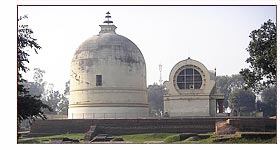
Kushinagar is another principal centre of Buddhism, worth a sincere admiration, is the place where Lord Buddha passed away at this place near the Hiranyavati River and was cremated at the Ramabhar stupa. It was once a celebrated center of the Malla kingdom. Many of its stupas and viharas date back to 230 BC-AD 413. when its prosperity was at the peak. In 543 BC, on a full moon night of Magh the legend delivered lecture to his Sangha and declared that he is going to leave the mortal world soon enough.
The excavations led by general Cunningham has revealed some antique artifacts and structures related to all sects of Buddhism. Kushinagar also expresses the common thread of all sects of Buddhism through its magnificent Viharas, Chaityas, temples and Tibetan monasteries. In ancient times, the town was also known as Kushinara and Kasia.
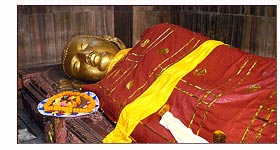 Wat Thai temple -
Wat Thai temple - The unique temple, built to celebrate the victory of King Bhumibol's great accession of the throne, and the subsequent Golden Jubilee, is worth a watch, especially because of the innumerable trees that were planted here.Besides, there's the Chinese temple, the Meditation Park and an International Buddha trust, and the Birla temple to add charm to roaming around in the city.
Ramabhar Stupa - About 1.5 km away from Mahaparinirvana Temple, this large Stupa rises to a height of 49 ft. It marks the site where the Lord Buddha was cremated. In ancient Buddhist texts, this Stupa has been referred to as 'Mukut-Bandhan Vihar'.
Japanese temple - A beautiful eight metals statue of the Buddha, which was brought from from Japan, can be visited here.
Excursions
Gorakhpur - Gorakhpur is an important Hindu destination, due to the numerous temples, including the Gorakhnath temple, the Vishnu temple, gita Vatika, Gita press, and the Arogya Mandir. Besides, there are important institutions of other religions such as the Imambara. The planetarium and the circuit house are also worth a visit.
Lumbini - This immensely important Buddhist pilgrimage, the birthplace of Lord Buddha, is in Nepal, at a distance of 122 km from Gorakhpur, houses some of the most important artifacts of literature and art related to the life of Lord Buddha.
How to get there
Air - Gorakhpur is the nearest airport, at a distance of 44 kms from the place. Kasia airstrip-5 Kms, Amausi airport Lucknow-252 Kms, Babatpur Airport in Varanasi-286 Kms.
Rail - The nearest railway station, a convenient one, is Gorakhpur, which is linked to important railway stations.
Road - The national highway numbered 28 connects the place with other important destinations of the state.
Where to stay ( Hotels -|- Temples/Monasteries )
There are accommodation facilities available, in the Dharmashalas and other charitable trusts. In Kushinagar, there's Hotel LOTUS NIKKO IS 55 kms from Gorakhpur railway station. International Guesthouse, Hindu brila Buddha Dharmashala, Nepalese Dharmashala etc are good places to stay. The UP Tourism accommodation, the Pathik Niwas is also quite good.

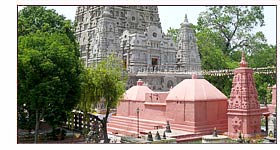 A place where Lord Buddha left his foot steps nearly 2500 years ago while travelling in the quest of enlightenment, situated by the river Phalgu, Bodhgaya is one of the most important and sacred Buddhist pilgrimage center in the world. It was here under a banyan tree, the Bodhi Tree, Gautama attained supreme knowledge to become Buddha,the Enlightened One. The serenity of the atmosphere remains in the subconscious soul of any visitor who takes the village as a pilgrimage that the Lord himself had chosen for meditation.
A place where Lord Buddha left his foot steps nearly 2500 years ago while travelling in the quest of enlightenment, situated by the river Phalgu, Bodhgaya is one of the most important and sacred Buddhist pilgrimage center in the world. It was here under a banyan tree, the Bodhi Tree, Gautama attained supreme knowledge to become Buddha,the Enlightened One. The serenity of the atmosphere remains in the subconscious soul of any visitor who takes the village as a pilgrimage that the Lord himself had chosen for meditation.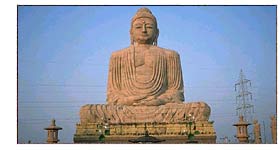 Rajgir - Rajgir (80 kms) was the capital of the mighty Magadhas, described in Mahabharata, during the 6th century BC. It is one of the most important tourist places in India. Being located in a valley, Rajgir is a very scenic place. The attractions include the Ajatshatru fort, Shanti Stupa, Venu van, Karanda tank, Sonbhandar caves, Bhimbisar jail, Gridhkuta and hot water springs and the forestry. There is an aerial ropeway for adding charm to the tour.
Rajgir - Rajgir (80 kms) was the capital of the mighty Magadhas, described in Mahabharata, during the 6th century BC. It is one of the most important tourist places in India. Being located in a valley, Rajgir is a very scenic place. The attractions include the Ajatshatru fort, Shanti Stupa, Venu van, Karanda tank, Sonbhandar caves, Bhimbisar jail, Gridhkuta and hot water springs and the forestry. There is an aerial ropeway for adding charm to the tour.




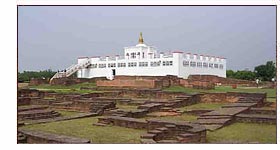
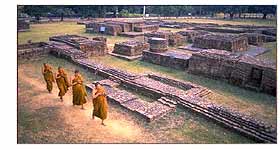
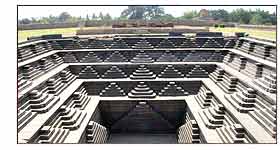 Excursions
Excursions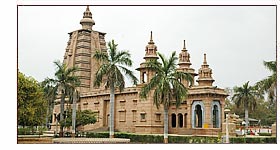
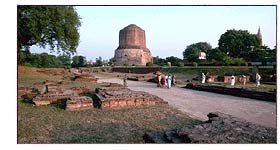
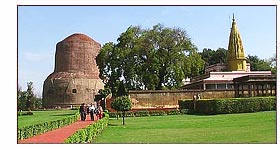 Ramnagar - If you belong to history, do visit this place, 14 km. from Varanasi. This fort and its museum are the repository of the history of the kings of Benaras. Built in the 18th century Ramnagar fort has carved balconies, open courtyards and picturesque pavilions. The Vidya Mandir museum, inside the darbar hall has a wide range of old armours, antique clocks, medieval costumes, gold & silver palanquins, silver Howdahs & jewellery on display.
Ramnagar - If you belong to history, do visit this place, 14 km. from Varanasi. This fort and its museum are the repository of the history of the kings of Benaras. Built in the 18th century Ramnagar fort has carved balconies, open courtyards and picturesque pavilions. The Vidya Mandir museum, inside the darbar hall has a wide range of old armours, antique clocks, medieval costumes, gold & silver palanquins, silver Howdahs & jewellery on display. Kushinagar is another principal centre of Buddhism, worth a sincere admiration, is the place where Lord Buddha passed away at this place near the Hiranyavati River and was cremated at the Ramabhar stupa. It was once a celebrated center of the Malla kingdom. Many of its stupas and viharas date back to 230 BC-AD 413. when its prosperity was at the peak. In 543 BC, on a full moon night of Magh the legend delivered lecture to his Sangha and declared that he is going to leave the mortal world soon enough.
Kushinagar is another principal centre of Buddhism, worth a sincere admiration, is the place where Lord Buddha passed away at this place near the Hiranyavati River and was cremated at the Ramabhar stupa. It was once a celebrated center of the Malla kingdom. Many of its stupas and viharas date back to 230 BC-AD 413. when its prosperity was at the peak. In 543 BC, on a full moon night of Magh the legend delivered lecture to his Sangha and declared that he is going to leave the mortal world soon enough. Wat Thai temple - The unique temple, built to celebrate the victory of King Bhumibol's great accession of the throne, and the subsequent Golden Jubilee, is worth a watch, especially because of the innumerable trees that were planted here.Besides, there's the Chinese temple, the Meditation Park and an International Buddha trust, and the Birla temple to add charm to roaming around in the city.
Wat Thai temple - The unique temple, built to celebrate the victory of King Bhumibol's great accession of the throne, and the subsequent Golden Jubilee, is worth a watch, especially because of the innumerable trees that were planted here.Besides, there's the Chinese temple, the Meditation Park and an International Buddha trust, and the Birla temple to add charm to roaming around in the city.